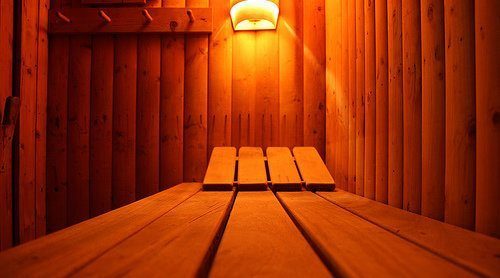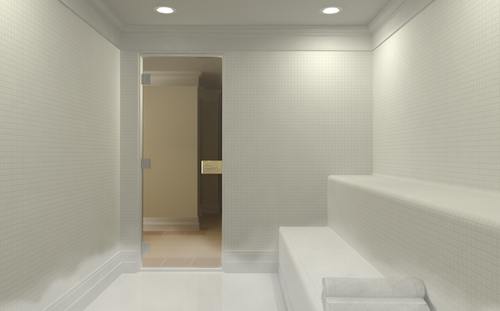Sauna vs Steam Room
Sauna
$2,900
(2-person, 4 x 8 x 3 ft, installed)
VS
Steam Room
$3,300
(2-person, 4 x 7 x 3 ft, installed)
Cost to install a sauna or a steam room varies greatly by region (and even by zip code).
To get free estimates from local contractors, please indicate yours.
Sauna

- Good for skin cleansing through perspiration
- Improves circulation
- Easier to maintain
- Increases resale value
- Induces deep sleep
- Easier to install
- Costs less
- Better choice for humidity-sensitive conditions
- Takes up interior space in the home
- Not for children or pregnant women
- Causes short-term male infertility
- Not a weight loss solution
(2-person, 4 x 8 x 3 ft, installed)
Get free advice and estimates from hot tub and spa specialists in your city.
Steam Room

- Good for skin cleansing through perspiration
- Improves circulation
- Can replace a traditional shower
- Better treatment for dry skin
- Increases resale value
- Induces deep sleep
- Generator must be located nearby
- Not for children or pregnant women
- Causes short-term male infertility
- Not a weight loss solution
- Costs slightly more
- Needs more frequent cleaning
- Professional installation required
- Poor choice for humidity-sensitive conditions
(2-person, 4 x 7 x 3 ft, installed)
Get free advice and estimates from hot tub and spa specialists in your city.
Reclining in a heated room is a relaxing way to end a stressful or physically exhausting day. In fact, many professionals recommend retiring to the sauna or steam room two or three times weekly to reap the natural benefits of heat therapy. To do this in your home is a luxury, and you will be able to decide whether that luxury will take the form of a sauna or steam room by using the information outlined below.
Heat Distribution
The primary difference between a sauna and steam room is the personal preference of the dry heat of a sauna over the moist heat of a steam room. In a traditional sauna, a heater warms a stack of sauna rocks, which then distribute dry heat throughout the space. It is possible to pour water over these rocks, creating steam, but this does not make the sauna as humid as a steam room. Saunas limit humidity by bringing in fresh air through a floor-level vent.
Infrared saunas distribute heat differently, using infrared light rather than a heater. Instead of the traditional sauna’s heat cycle, which heats the air which heats your body, the infrared sauna heats your body directly without warming the surrounding air. The desired results of sweating and increased circulation are attained at a lower temperature. While the myriad of health benefits claimed by those promoting infrared saunas have not been proven, no adverse effects have been reported regarding their use. This type of sauna is a viable option for someone who wants dry sauna results without the high temperatures.
A steam room is sometimes called a steam shower since small- to medium-sized steam rooms can be installed instead of a traditional shower. The standard showerhead exists in addition to a steam outlet. A steam room uses an external steam generator to boil water into steam, releasing the steam into the room through the steam outlet. The watertight construction of the steam room keeps the humidity level at 100 percent, offering a full moist heat experience.
Temperature
The saying “It’s a dry heat” is correct. Low-humidity heat feels less hot to the body than high-humidity heat. For this reason, the low humidity of a sauna is hotter in temperature than the inside of a steam room, but the body does not feel the difference. The normal temperature of a sauna is 160 to 200 degrees Fahrenheit with 5 to 30 percent humidity. In a steam room, the average temperature is 110 to 120 degrees Fahrenheit with a humidity of 100 percent. Because of the high humidity, your sweat does not evaporate, and you feel hotter at a lower temperature. Whether you prefer a higher temperature with lower humidity or lower heat at higher humidity is a personal preference. Your body will enjoy similar results.
Installation
Installing a traditional sauna is a quicker and less complicated process than installing a steam shower. However, installing a sauna means taking up interior space or building at least a modular enclosure outdoors, so each installation has its pros and cons.
The sauna will likely be built from a pre-cut kit in a bedroom, a basement, or other space in the home. Although this can be a DIY job, at least two steps may need professional assistance. An electrician will be required to wire the light, light switch, and sauna heater controls. If the heater is gas, a plumber will be needed as well.
An infrared sauna is similar in construction except that no heater is needed. Because of this, the infrared sauna can be quickly and easily installed by a professional who will build the kit contents from the floor up using little more than a screwdriver, wrench, some electrical expertise, and a little heavy lifting.
Because a steam room requires a drain, most home retrofit installations are done by replacing a shower with a steam shower. This complex job of demolishing the existing shower and installing the new steam shower is best left to a professional. Steam cannot simply be added to an existing shower. Several characteristics make steam showers unique, including a seat, watertight seal, sloped ceiling, and a ceiling height of no more than eight feet. Also, the steam generator must be nearby, perhaps in a closet or cabinet.
Materials
Design and construction materials are different for saunas and steam rooms. The higher temperature and lower humidity of saunas make wood an excellent choice for all parts of the room. Wooden seats do not retain the heat of the air. Therefore, they are more comfortable to sit on, even in the high heat. Also, wood is porous and pulls moisture from the air, keeping the humidity low. This same porous quality makes wood a poor choice for a steam room, however. The constant moisture would break down the wood quickly. Non-porous materials such as tile, plastic, or glass, meet the needs of the steam room perfectly.
Costs
A traditional sauna that will seat one to two people, approximately 4 x 8 x 3 feet, will cost about $1,400 for the prefabricated unit with all the materials. Although a DIY homeowner may be able to install the kit, a professional electrician will be necessary for wiring the various electrical elements. Labor added to a DIY project will cost about $350 to $700. Labor for the kit to be installed entirely by a professional will be approximately $1,000 to $2,000. An entire two-person sauna professionally installed will cost about $2,900.
The materials for a one- to two-person steam shower will cost between $1,000 and $5,000, and the labor to install the unit will cost between $1,170 and $1,290. The total cost for a professionally installed two-person steam shower will be about $3,300. A custom steam room will cost much more, from $2,500 to $8,000 without installation, the cost of the shower door, or the cost of the steam generator.
Weight-loss effects
Many claims regarding weight loss are made by distributors and manufacturers of saunas and steam rooms. They say that the intense heat raises the metabolism and burns calories as if you were exercising. Not everyone agrees with this, however. According to health professionals at Columbia University, these effects are often overstated, and the loss is usually due to slight dehydration. Once the balance of water in the body is restored, the weight is regained.
Sleeping
Either a sauna or steam room induces deep sleep. During this portion of your sleep, the brain processes memories and restores brain functions. This is much like the effect of prolonged exercise on the sleep center of the brain.
Skin Cleansing and Other Health Benefits
The health benefits of saunas and steam rooms are similar. Both are good for muscle tension reduction, mental relaxation, and general good health. Other advantages are the cleansing of the skin, increased circulation, and improved function of the immune and lymphatic systems.
A sauna is a better choice for people with health conditions that can be aggravated by humidity like rheumatoid arthritis, fibromyalgia, asthma, or headaches. Steam rooms hydrate the skin better than saunas, making them a good choice if you have dry skin.
Health risks
Newer studies from the American Heart Association rescind their previous warnings to people with high blood pressure or heart disease. They only caution that these individuals avoid moving from hot areas to cold areas repeatedly since this action can cause a rise in blood pressure. Temporary infertility in men can be caused by even short-term use of intense heat. The Centers for Disease Control offers the following cautions. Never allow a child under five to use a sauna or steam room. Pregnant women should also avoid both. No one should mix the use of alcohol or sleep-inducing drugs with sauna or steam room use.
Even healthy individuals without these limitations should limit their first visits to 15 minutes or less. This is especially true of steam rooms. A steam room cannot be tolerated as long as a sauna because the sweat of your body does not evaporate and cool you internally. Also, anyone who enjoys a sauna or steam room should immediately hydrate with several glasses of water.
Legal Concerns
Homeowners are always liable for the safety of their guests. Therefore, all of the above security information should be shared with anyone visiting the home’s sauna or steam room. Liability can result from any illness or injury a guest may suffer.
Another legal concern is the possibility of an outdoor sauna or steam room being labeled an attractive menace, a legal term that means that a home’s feature can be inviting to trespassers, especially children. Always check with zoning or municipal ordinances to ensure that you will be safe from possible liability should a trespasser be injured.
Resale Value
A steam room or steam shower is a great investment. It is reported that 60 to 70 percent of homeowners request some spa element in their new homes. A sauna also increases the value of a home, and it is seen as a luxury item that is even more valuable in an upscale neighborhood accustomed to such luxuries.
How much does it cost to install a sauna or a steam room in my city?
Cost to install a sauna or a steam room varies greatly by region (and even by zip code).
To get free estimates from local contractors, please indicate yours.